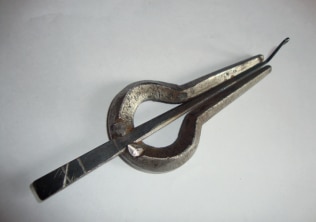Masood Ashraf, USA

Throughout history, many artefacts have baffled archaeologists, historians and scientists for various reasons. Such items that remain mysterious and unclear include the full explanation of King Tutankhamun’s tomb and burial, the cursed Amethyst and the Hasanlu lovers.
However, as the years progress, more artefacts resurface with new contextual evidence, giving researchers deeper insight into their origin, story and history.
Another particular item which caught my attention while visiting the Museum of Fine Arts in Boston was a musical instrument from Afghanistan named: “Jew’s harp”.
The Museum of Fine Arts, Boston has a vast array of musical instruments from all around the world. Roaming through the halls of the museum, you will eventually stumble on a section filled with Afghani instruments, and one that caught my attention was a little instrument which was oddly enough named “Jew’s harp”.
This is a musical instrument consisting of a metal frame and a reed that can create wistful melodious sounds when played correctly. It is a lyre-shaped instrument that is played by placing it in one’s mouth and plucking the reed in the centre, creating a sound similar to flicking a plastic card or hearing a vibration.
But why is it called the Jew’s harp when it has no relation to the Jewish faith or people? Or has it?
Origin of the Jew’s harp
The instrument’s origin and story are still shrouded in mystery as there have been multiple hypotheses and theories from different institutions suggesting the relevance of the instrument and its name.
The Jew’s harp has been the subject of much debate and most of the disagreement is regarding its name and origin. Some argue that the instrument is not actually called the Jew’s harp and that it is simply a misinterpretation of the French name “jeu harpes” or “jeu trompe”, while others claim its original name was “jaws” harp, even though this name did not appear until the late 18th century.
People have claimed that the first version of this instrument was created from bamboo and wood in China before spreading to countries in Southeast Asia. (History of Jew’s Harp, www.jewsharpguild.org/history.html) However, others argue that the form of the instrument in Asia was incomplete and that the actual, fully-formed version was made in Europe after Europeans colonised Asia. The Europeans supposedly gave it its formal “lyre” shape and made it with a sturdier metal material rather than wood. (Ibid)
Depending on where an individual believes the instrument came from, the name they attribute to it also changes.
Afghanistan and the Jews: Research by Hazrat Mirza Ghulam Ahmadas
However, most still claim that the name “Jew’s harp” doesn’t fit anywhere since the instrument has nothing to do with Jews, and this is where they are incorrect.
This instrument was incredibly popular in Afghanistan which is why it is displayed as their instrument in the Museum of Fine Arts, Boston, and it is because of Afghanistan that the name “Jew’s” harp fits very well.
Afghanistan is now a Muslim dominant country, so the idea of this ancient instrument being called the “Jew’s” harp seems far-fetched. However, many do not take into consideration what Afghanistan was like centuries before it became Islamic and one such explanation can be evidenced when one analyses its antiquity further paralleled with the wisdom and research of the Promised Messiah, Hazrat Mirza Ghulam Ahmadas.
Afghanistan was a predominantly Jewish region thousands of years ago and despite the decline of the religion in the country over the years, many of their cultural habits, synagogues and other historical monuments still exist. The people of Afghanistan have openly admitted that they are descendants of the Qais, and the Qais are a part of the house of Israel, proving that the Afghans were once Israelites. According to history, Jesusas was travelling to Kashmir from Jerusalem to spread his message, and on his path, he crossed several countries including Iran and Afghanistan. Instead of taking a path known as Chitral to cross from Afghanistan to Kashmir, he purposely chose to travel straight through Afghanistan since he believed the lost tribes of Israel would reap some benefits from his message and presence. (Jesus in India by Hazrat Mirza Ghulam Ahmadas)
In the Geography Encyclopaedia by James Bryce, FGS (London, 1856), on page 11, it is stated that the Afghans trace their genealogy to Saul, the Israelite King, and call themselves the descendants of Israel. Alexander Burns says that the Afghans say they are of Jewish origin; that the King of Babel captured them and settled them in the territory of Ghor which lies to the northwest of Kabul; that up to 622 AD they continued to hold on to the Jewish faith, but later Khalid bin Abdullah (Abdullah has been written mistakenly instead of Walid) married the daughter of a chief of this tribe and made them accept Islam in that year. (Ibid).The Promised Messiahas in the book Jesus in India has given much evidence from history, local culture, and etymology of city names in Afghanistan and proved that the Afghans are in fact descendants of Israelites. To me, seeing the name of the musical instrument proved further that the Afghans were truly Israelites, and the popular ancient instrument simply adopted the name of the people who used it; The Jews.

